2013 NISSAN GT-R Vdc
[x] Cancel search: VdcPage 8 of 346
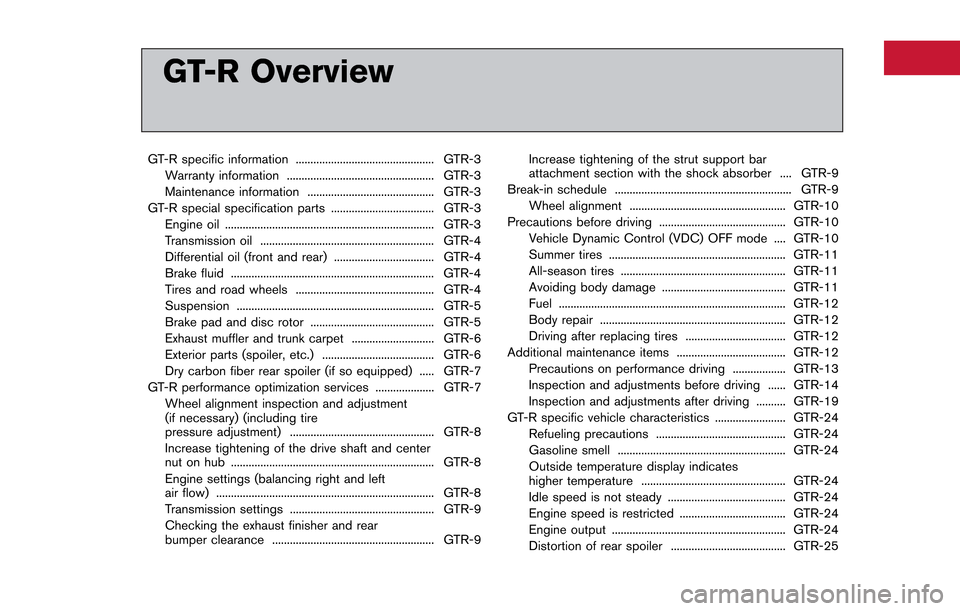
GT-R Overview
GT-R specific information ............................................... GTR-3Warranty information .................................................. GTR-3
Maintenance information ........................................... GTR-3
GT-R special specification parts ................................... GTR-3 Engine oil ....................................................................... GTR-3
Transmission oil ........................................................... GTR-4
Differential oil (front and rear) .................................. GTR-4
Brake fluid ..................................................................... GTR-4
Tires and road wheels ............................................... GTR-4
Suspension ................................................................... GTR-5
Brake pad and disc rotor .......................................... GTR-5
Exhaust muffler and trunk carpet ............................ GTR-6
Exterior parts (spoiler, etc.) ...................................... GTR-6
Dry carbon fiber rear spoiler (if so equipped) ..... GTR-7
GT-R performance optimization services .................... GTR-7 Wheel alignment inspection and adjustment
(if necessary) (including tire
pressure adjustment) ................................................. GTR-8
Increase tightening of the drive shaft and center
nut on hub ..................................................................... GTR-8
Engine settings (balancing right and left
air flow) ........................................................................\
.. GTR-8
Transmission settings ................................................. GTR-9
Checking the exhaust finisher and rear
bumper clearance ....................................................... GTR-9 Increase tightening of the strut support bar
attachment section with the shock absorber .... GTR-9
Break-in schedule ............................................................ GTR-9
Wheel alignment ..................................................... GTR-10
Precautions before driving ........................................... GTR-10 Vehicle Dynamic Control (VDC) OFF mode .... GTR-10
Summer tires ............................................................ GTR-11
All-season tires ........................................................ GTR-11
Avoiding body damage .......................................... GTR-11
Fuel ........................................................................\
..... GTR-12
Body repair ............................................................... GTR-12
Driving after replacing tires .................................. GTR-12
Additional maintenance items ..................................... GTR-12
Precautions on performance driving .................. GTR-13
Inspection and adjustments before driving ...... GTR-14
Inspection and adjustments after driving .......... GTR-19
GT-R specific vehicle characteristics ........................ GTR-24 Refueling precautions ............................................ GTR-24
Gasoline smell ......................................................... GTR-24
Outside temperature display indicates
higher temperature ................................................. GTR-24
Idle speed is not steady ........................................ GTR-24
Engine speed is restricted .................................... GTR-24
Engine output ........................................................... GTR-24
Distortion of rear spoiler ....................................... GTR-25
Page 10 of 346
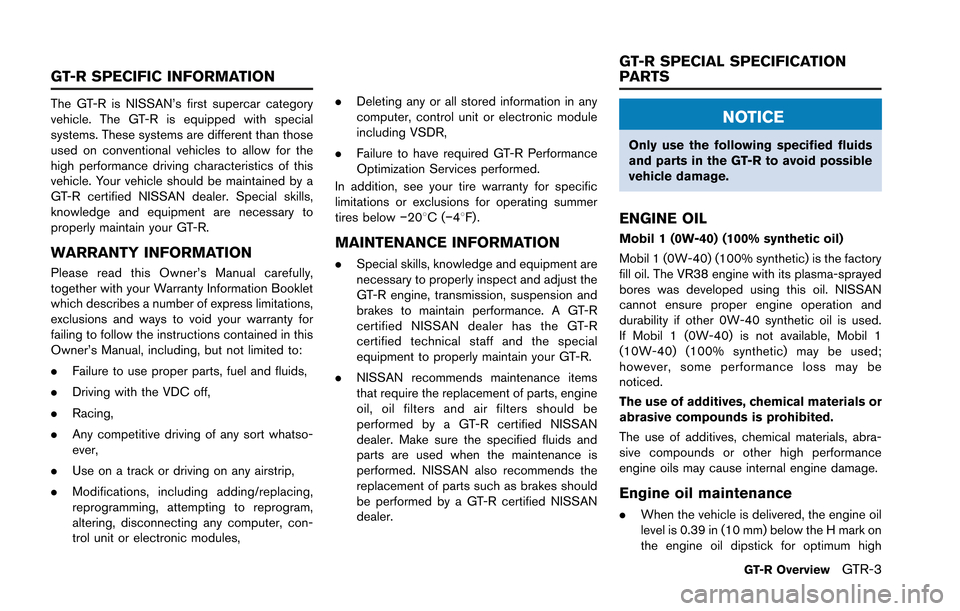
The GT-R is NISSAN’s first supercar category
vehicle. The GT-R is equipped with special
systems. These systems are different than those
used on conventional vehicles to allow for the
high performance driving characteristics of this
vehicle. Your vehicle should be maintained by a
GT-R certified NISSAN dealer. Special skills,
knowledge and equipment are necessary to
properly maintain your GT-R.
WARRANTY INFORMATION
Please read this Owner’s Manual carefully,
together with your Warranty Information Booklet
which describes a number of express limitations,
exclusions and ways to void your warranty for
failing to follow the instructions contained in this
Owner’s Manual, including, but not limited to:
.Failure to use proper parts, fuel and fluids,
. Driving with the VDC off,
. Racing,
. Any competitive driving of any sort whatso-
ever,
. Use on a track or driving on any airstrip,
. Modifications, including adding/replacing,
reprogramming, attempting to reprogram,
altering, disconnecting any computer, con-
trol unit or electronic modules, .
Deleting any or all stored information in any
computer, control unit or electronic module
including VSDR,
. Failure to have required GT-R Performance
Optimization Services performed.
In addition, see your tire warranty for specific
limitations or exclusions for operating summer
tires below −208C(−48F) .
MAINTENANCE INFORMATION
.Special skills, knowledge and equipment are
necessary to properly inspect and adjust the
GT-R engine, transmission, suspension and
brakes to maintain performance. A GT-R
certified NISSAN dealer has the GT-R
certified technical staff and the special
equipment to properly maintain your GT-R.
. NISSAN recommends maintenance items
that require the replacement of parts, engine
oil, oil filters and air filters should be
performed by a GT-R certified NISSAN
dealer. Make sure the specified fluids and
parts are used when the maintenance is
performed. NISSAN also recommends the
replacement of parts such as brakes should
be performed by a GT-R certified NISSAN
dealer.
NOTICE
Only use the following specified fluids
and parts in the GT-R to avoid possible
vehicle damage.
ENGINE OIL
Mobil 1 (0W-40) (100% synthetic oil)
Mobil 1 (0W-40) (100% synthetic) is the factory
fill oil. The VR38 engine with its plasma-sprayed
bores was developed using this oil. NISSAN
cannot ensure proper engine operation and
durability if other 0W-40 synthetic oil is used.
If Mobil 1 (0W-40) is not available, Mobil 1
(10W-40) (100% synthetic) may be used;
however, some performance loss may be
noticed.
The use of additives, chemical materials or
abrasive compounds is prohibited.
The use of additives, chemical materials, abra-
sive compounds or other high performance
engine oils may cause internal engine damage.
Engine oil maintenance
.When the vehicle is delivered, the engine oil
level is 0.39 in (10 mm) below the H mark on
the engine oil dipstick for optimum high
GT-R OverviewGTR-3
GT-R SPECIFIC INFORMATION GT-R SPECIAL SPECIFICATION
PARTS
Page 11 of 346
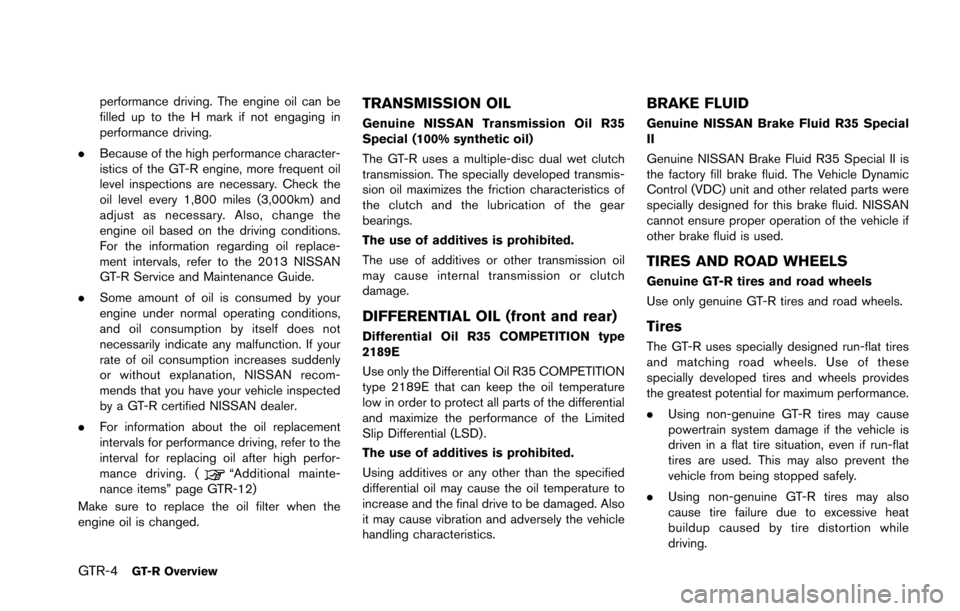
GTR-4GT-R Overview
performance driving. The engine oil can be
filled up to the H mark if not engaging in
performance driving.
. Because of the high performance character-
istics of the GT-R engine, more frequent oil
level inspections are necessary. Check the
oil level every 1,800 miles (3,000km) and
adjust as necessary. Also, change the
engine oil based on the driving conditions.
For the information regarding oil replace-
ment intervals, refer to the 2013 NISSAN
GT-R Service and Maintenance Guide.
. Some amount of oil is consumed by your
engine under normal operating conditions,
and oil consumption by itself does not
necessarily indicate any malfunction. If your
rate of oil consumption increases suddenly
or without explanation, NISSAN recom-
mends that you have your vehicle inspected
by a GT-R certified NISSAN dealer.
. For information about the oil replacement
intervals for performance driving, refer to the
interval for replacing oil after high perfor-
mance driving. (
“Additional mainte-
nance items” page GTR-12)
Make sure to replace the oil filter when the
engine oil is changed.
TRANSMISSION OIL
Genuine NISSAN Transmission Oil R35
Special (100% synthetic oil)
The GT-R uses a multiple-disc dual wet clutch
transmission. The specially developed transmis-
sion oil maximizes the friction characteristics of
the clutch and the lubrication of the gear
bearings.
The use of additives is prohibited.
The use of additives or other transmission oil
may cause internal transmission or clutch
damage.
DIFFERENTIAL OIL (front and rear)
Differential Oil R35 COMPETITION type
2189E
Use only the Differential Oil R35 COMPETITION
type 2189E that can keep the oil temperature
low in order to protect all parts of the differential
and maximize the performance of the Limited
Slip Differential (LSD) .
The use of additives is prohibited.
Using additives or any other than the specified
differential oil may cause the oil temperature to
increase and the final drive to be damaged. Also
it may cause vibration and adversely the vehicle
handling characteristics.
BRAKE FLUID
Genuine NISSAN Brake Fluid R35 Special
II
Genuine NISSAN Brake Fluid R35 Special II is
the factory fill brake fluid. The Vehicle Dynamic
Control (VDC) unit and other related parts were
specially designed for this brake fluid. NISSAN
cannot ensure proper operation of the vehicle if
other brake fluid is used.
TIRES AND ROAD WHEELS
Genuine GT-R tires and road wheels
Use only genuine GT-R tires and road wheels.
Tires
The GT-R uses specially designed run-flat tires
and matching road wheels. Use of these
specially developed tires and wheels provides
the greatest potential for maximum performance.
. Using non-genuine GT-R tires may cause
powertrain system damage if the vehicle is
driven in a flat tire situation, even if run-flat
tires are used. This may also prevent the
vehicle from being stopped safely.
. Using non-genuine GT-R tires may also
cause tire failure due to excessive heat
buildup caused by tire distortion while
driving.
Page 12 of 346
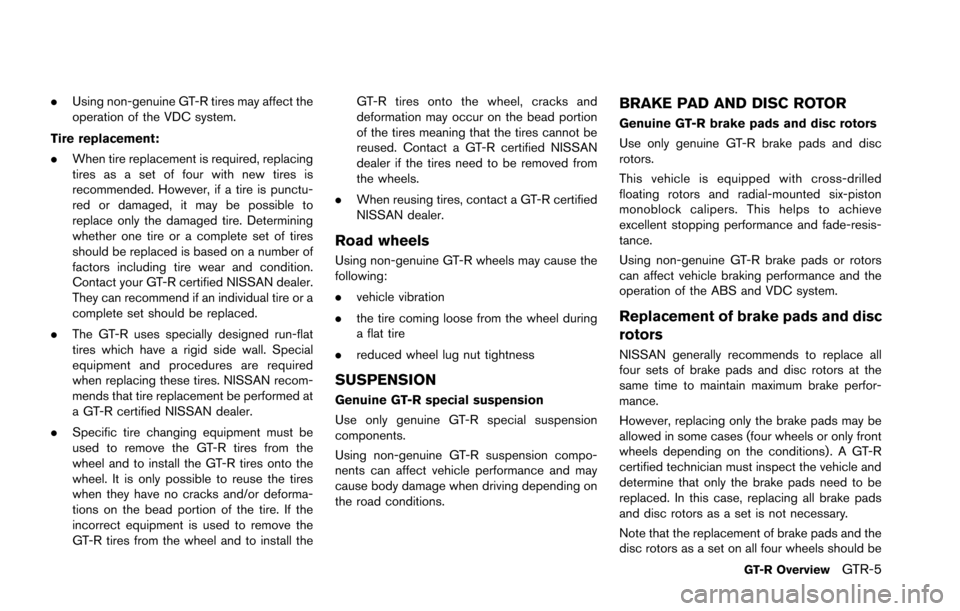
.Using non-genuine GT-R tires may affect the
operation of the VDC system.
Tire replacement:
. When tire replacement is required, replacing
tires as a set of four with new tires is
recommended. However, if a tire is punctu-
red or damaged, it may be possible to
replace only the damaged tire. Determining
whether one tire or a complete set of tires
should be replaced is based on a number of
factors including tire wear and condition.
Contact your GT-R certified NISSAN dealer.
They can recommend if an individual tire or a
complete set should be replaced.
. The GT-R uses specially designed run-flat
tires which have a rigid side wall. Special
equipment and procedures are required
when replacing these tires. NISSAN recom-
mends that tire replacement be performed at
a GT-R certified NISSAN dealer.
. Specific tire changing equipment must be
used to remove the GT-R tires from the
wheel and to install the GT-R tires onto the
wheel. It is only possible to reuse the tires
when they have no cracks and/or deforma-
tions on the bead portion of the tire. If the
incorrect equipment is used to remove the
GT-R tires from the wheel and to install the GT-R tires onto the wheel, cracks and
deformation may occur on the bead portion
of the tires meaning that the tires cannot be
reused. Contact a GT-R certified NISSAN
dealer if the tires need to be removed from
the wheels.
. When reusing tires, contact a GT-R certified
NISSAN dealer.
Road wheels
Using non-genuine GT-R wheels may cause the
following:
.vehicle vibration
. the tire coming loose from the wheel during
a flat tire
. reduced wheel lug nut tightness
SUSPENSION
Genuine GT-R special suspension
Use only genuine GT-R special suspension
components.
Using non-genuine GT-R suspension compo-
nents can affect vehicle performance and may
cause body damage when driving depending on
the road conditions.
BRAKE PAD AND DISC ROTOR
Genuine GT-R brake pads and disc rotors
Use only genuine GT-R brake pads and disc
rotors.
This vehicle is equipped with cross-drilled
floating rotors and radial-mounted six-piston
monoblock calipers. This helps to achieve
excellent stopping performance and fade-resis-
tance.
Using non-genuine GT-R brake pads or rotors
can affect vehicle braking performance and the
operation of the ABS and VDC system.
Replacement of brake pads and disc
rotors
NISSAN generally recommends to replace all
four sets of brake pads and disc rotors at the
same time to maintain maximum brake perfor-
mance.
However, replacing only the brake pads may be
allowed in some cases (four wheels or only front
wheels depending on the conditions). A GT-R
certified technician must inspect the vehicle and
determine that only the brake pads need to be
replaced. In this case, replacing all brake pads
and disc rotors as a set is not necessary.
Note that the replacement of brake pads and the
disc rotors as a set on all four wheels should be
GT-R OverviewGTR-5
Page 13 of 346
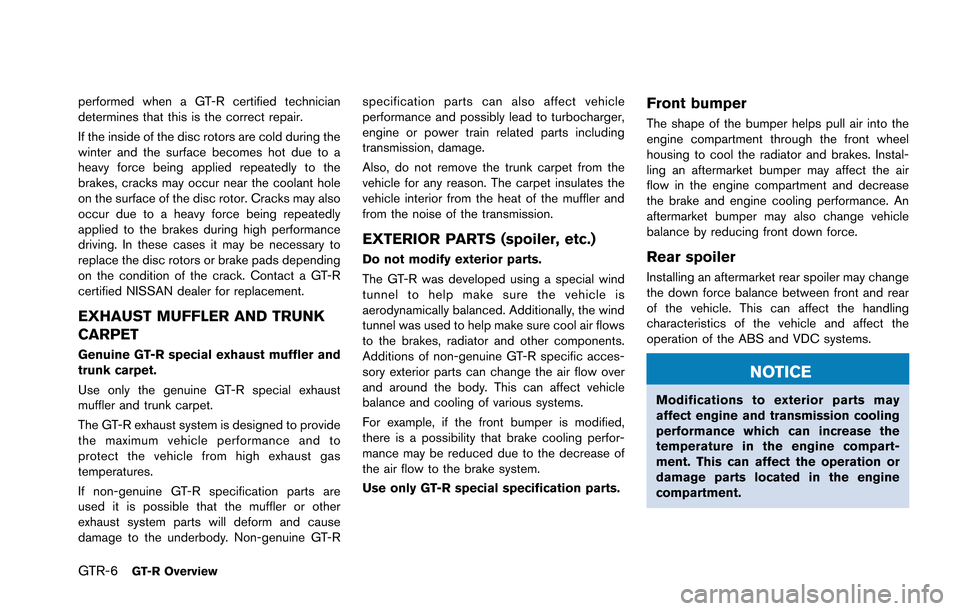
GTR-6GT-R Overview
performed when a GT-R certified technician
determines that this is the correct repair.
If the inside of the disc rotors are cold during the
winter and the surface becomes hot due to a
heavy force being applied repeatedly to the
brakes, cracks may occur near the coolant hole
on the surface of the disc rotor. Cracks may also
occur due to a heavy force being repeatedly
applied to the brakes during high performance
driving. In these cases it may be necessary to
replace the disc rotors or brake pads depending
on the condition of the crack. Contact a GT-R
certified NISSAN dealer for replacement.
EXHAUST MUFFLER AND TRUNK
CARPET
Genuine GT-R special exhaust muffler and
trunk carpet.
Use only the genuine GT-R special exhaust
muffler and trunk carpet.
The GT-R exhaust system is designed to provide
the maximum vehicle performance and to
protect the vehicle from high exhaust gas
temperatures.
If non-genuine GT-R specification parts are
used it is possible that the muffler or other
exhaust system parts will deform and cause
damage to the underbody. Non-genuine GT-Rspecification parts can also affect vehicle
performance and possibly lead to turbocharger,
engine or power train related parts including
transmission, damage.
Also, do not remove the trunk carpet from the
vehicle for any reason. The carpet insulates the
vehicle interior from the heat of the muffler and
from the noise of the transmission.
EXTERIOR PARTS (spoiler, etc.)
Do not modify exterior parts.
The GT-R was developed using a special wind
tunnel to help make sure the vehicle is
aerodynamically balanced. Additionally, the wind
tunnel was used to help make sure cool air flows
to the brakes, radiator and other components.
Additions of non-genuine GT-R specific acces-
sory exterior parts can change the air flow over
and around the body. This can affect vehicle
balance and cooling of various systems.
For example, if the front bumper is modified,
there is a possibility that brake cooling perfor-
mance may be reduced due to the decrease of
the air flow to the brake system.
Use only GT-R special specification parts.
Front bumper
The shape of the bumper helps pull air into the
engine compartment through the front wheel
housing to cool the radiator and brakes. Instal-
ling an aftermarket bumper may affect the air
flow in the engine compartment and decrease
the brake and engine cooling performance. An
aftermarket bumper may also change vehicle
balance by reducing front down force.
Rear spoiler
Installing an aftermarket rear spoiler may change
the down force balance between front and rear
of the vehicle. This can affect the handling
characteristics of the vehicle and affect the
operation of the ABS and VDC systems.
NOTICE
Modifications to exterior parts may
affect engine and transmission cooling
performance which can increase the
temperature in the engine compart-
ment. This can affect the operation or
damage parts located in the engine
compartment.
Page 17 of 346
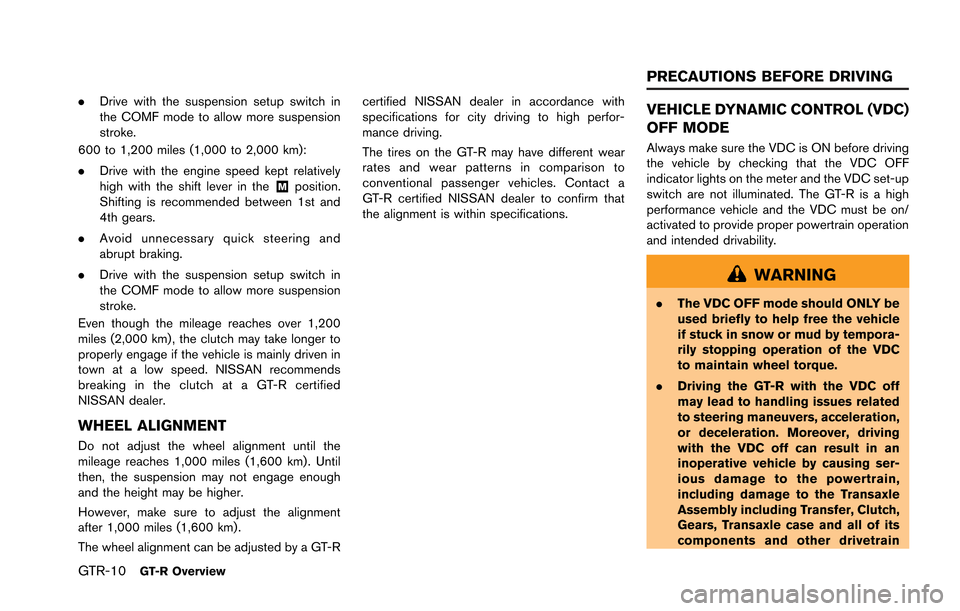
GTR-10GT-R Overview
.Drive with the suspension setup switch in
the COMF mode to allow more suspension
stroke.
600 to 1,200 miles (1,000 to 2,000 km):
. Drive with the engine speed kept relatively
high with the shift lever in the
&Mposition.
Shifting is recommended between 1st and
4th gears.
. Avoid unnecessary quick steering and
abrupt braking.
. Drive with the suspension setup switch in
the COMF mode to allow more suspension
stroke.
Even though the mileage reaches over 1,200
miles (2,000 km) , the clutch may take longer to
properly engage if the vehicle is mainly driven in
town at a low speed. NISSAN recommends
breaking in the clutch at a GT-R certified
NISSAN dealer.
WHEEL ALIGNMENT
Do not adjust the wheel alignment until the
mileage reaches 1,000 miles (1,600 km). Until
then, the suspension may not engage enough
and the height may be higher.
However, make sure to adjust the alignment
after 1,000 miles (1,600 km) .
The wheel alignment can be adjusted by a GT-R certified NISSAN dealer in accordance with
specifications for city driving to high perfor-
mance driving.
The tires on the GT-R may have different wear
rates and wear patterns in comparison to
conventional passenger vehicles. Contact a
GT-R certified NISSAN dealer to confirm that
the alignment is within specifications.
VEHICLE DYNAMIC CONTROL (VDC)
OFF MODE
Always make sure the VDC is ON before driving
the vehicle by checking that the VDC OFF
indicator lights on the meter and the VDC set-up
switch are not illuminated. The GT-R is a high
performance vehicle and the VDC must be on/
activated to provide proper powertrain operation
and intended drivability.
WARNING
.
The VDC OFF mode should ONLY be
used briefly to help free the vehicle
if stuck in snow or mud by tempora-
rily stopping operation of the VDC
to maintain wheel torque.
. Driving the GT-R with the VDC off
may lead to handling issues related
to steering maneuvers, acceleration,
or deceleration. Moreover, driving
with the VDC off can result in an
inoperative vehicle by causing ser-
ious damage to the powertrain,
including damage to the Transaxle
Assembly including Transfer, Clutch,
Gears, Transaxle case and all of its
components and other drivetrain
PRECAUTIONS BEFORE DRIVING
Page 18 of 346
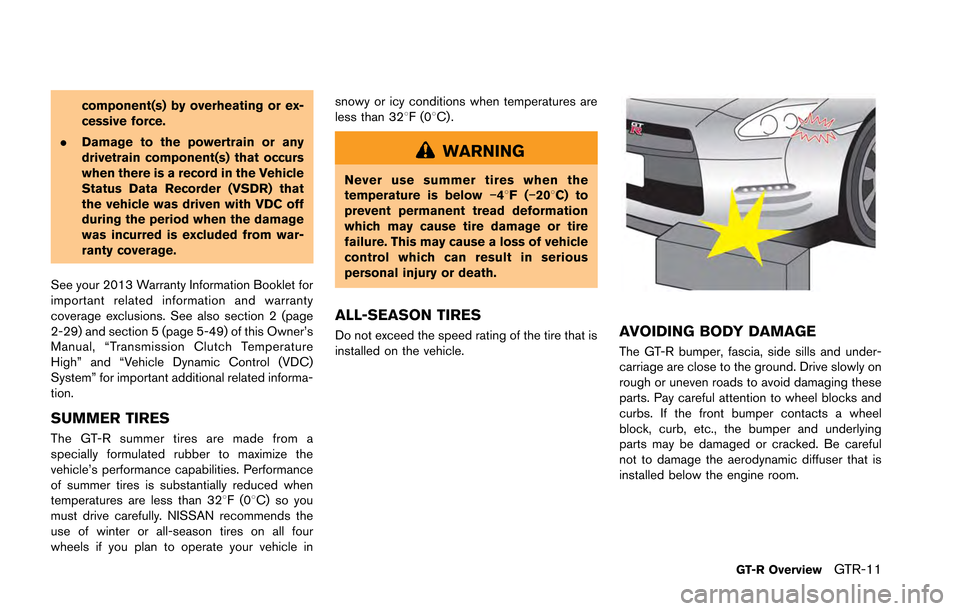
component(s) by overheating or ex-
cessive force.
. Damage to the powertrain or any
drivetrain component(s) that occurs
when there is a record in the Vehicle
Status Data Recorder (VSDR) that
the vehicle was driven with VDC off
during the period when the damage
was incurred is excluded from war-
ranty coverage.
See your 2013 Warranty Information Booklet for
important related information and warranty
coverage exclusions. See also section 2 (page
2-29) and section 5 (page 5-49) of this Owner’s
Manual, “Transmission Clutch Temperature
High” and “Vehicle Dynamic Control (VDC)
System” for important additional related informa-
tion.
SUMMER TIRES
The GT-R summer tires are made from a
specially formulated rubber to maximize the
vehicle’s performance capabilities. Performance
of summer tires is substantially reduced when
temperatures are less than 328F(0 8C) so you
must drive carefully. NISSAN recommends the
use of winter or all-season tires on all four
wheels if you plan to operate your vehicle in snowy or icy conditions when temperatures are
less than 328F(0
8C) .
WARNING
Never use summer tires when the
temperature is below −48F(−208C) to
prevent permanent tread deformation
which may cause tire damage or tire
failure. This may cause a loss of vehicle
control which can result in serious
personal injury or death.
ALL-SEASON TIRES
Do not exceed the speed rating of the tire that is
installed on the vehicle.AVOIDING BODY DAMAGE
The GT-R bumper, fascia, side sills and under-
carriage are close to the ground. Drive slowly on
rough or uneven roads to avoid damaging these
parts. Pay careful attention to wheel blocks and
curbs. If the front bumper contacts a wheel
block, curb, etc., the bumper and underlying
parts may be damaged or cracked. Be careful
not to damage the aerodynamic diffuser that is
installed below the engine room.
GT-R OverviewGTR-11
Page 25 of 346
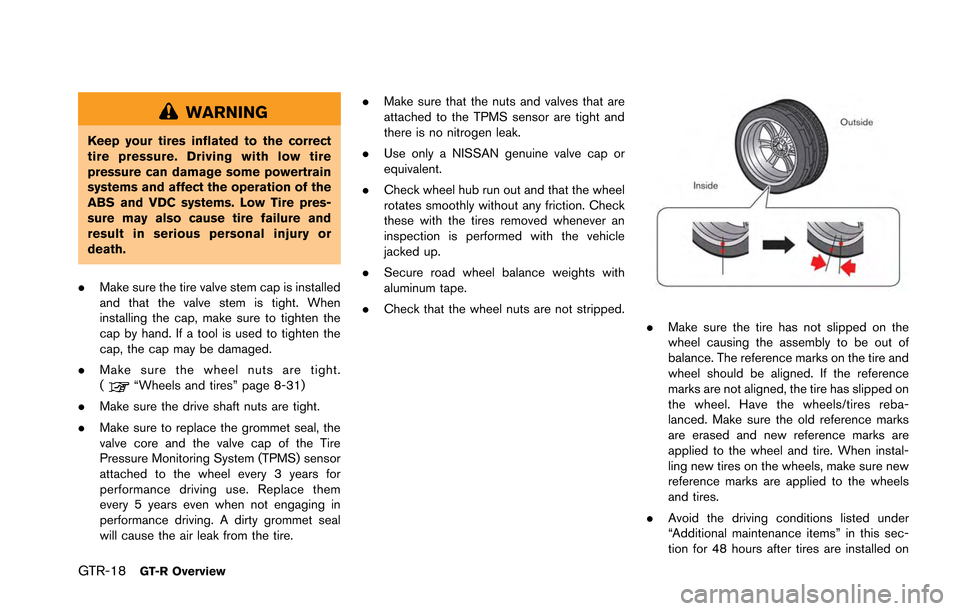
GTR-18GT-R Overview
WARNING
Keep your tires inflated to the correct
tire pressure. Driving with low tire
pressure can damage some powertrain
systems and affect the operation of the
ABS and VDC systems. Low Tire pres-
sure may also cause tire failure and
result in serious personal injury or
death.
. Make sure the tire valve stem cap is installed
and that the valve stem is tight. When
installing the cap, make sure to tighten the
cap by hand. If a tool is used to tighten the
cap, the cap may be damaged.
. Make sure the wheel nuts are tight.
(
“Wheels and tires” page 8-31)
. Make sure the drive shaft nuts are tight.
. Make sure to replace the grommet seal, the
valve core and the valve cap of the Tire
Pressure Monitoring System (TPMS) sensor
attached to the wheel every 3 years for
performance driving use. Replace them
every 5 years even when not engaging in
performance driving. A dirty grommet seal
will cause the air leak from the tire. .
Make sure that the nuts and valves that are
attached to the TPMS sensor are tight and
there is no nitrogen leak.
. Use only a NISSAN genuine valve cap or
equivalent.
. Check wheel hub run out and that the wheel
rotates smoothly without any friction. Check
these with the tires removed whenever an
inspection is performed with the vehicle
jacked up.
. Secure road wheel balance weights with
aluminum tape.
. Check that the wheel nuts are not stripped.
.Make sure the tire has not slipped on the
wheel causing the assembly to be out of
balance. The reference marks on the tire and
wheel should be aligned. If the reference
marks are not aligned, the tire has slipped on
the wheel. Have the wheels/tires reba-
lanced. Make sure the old reference marks
are erased and new reference marks are
applied to the wheel and tire. When instal-
ling new tires on the wheels, make sure new
reference marks are applied to the wheels
and tires.
. Avoid the driving conditions listed under
“Additional maintenance items” in this sec-
tion for 48 hours after tires are installed on